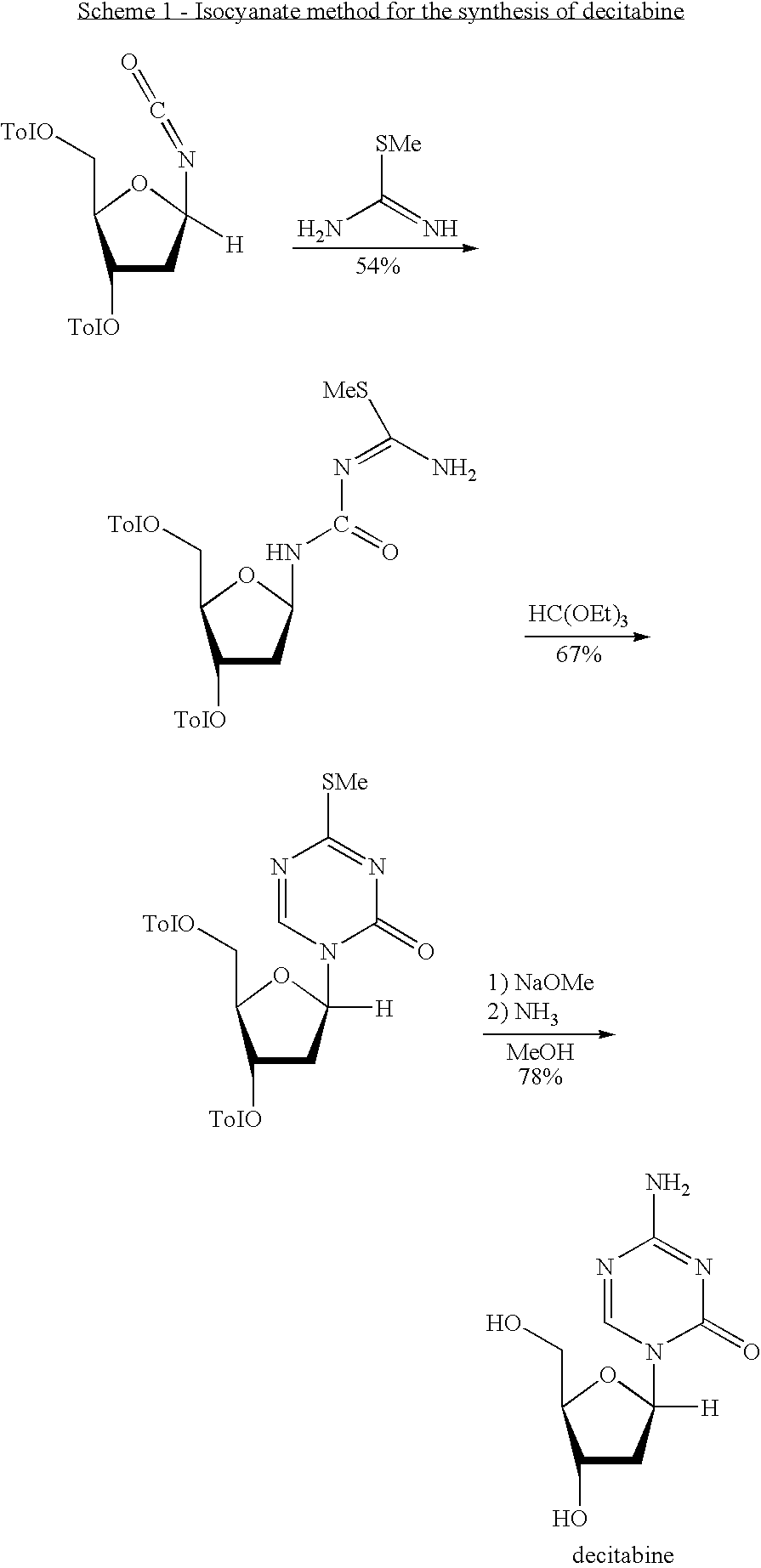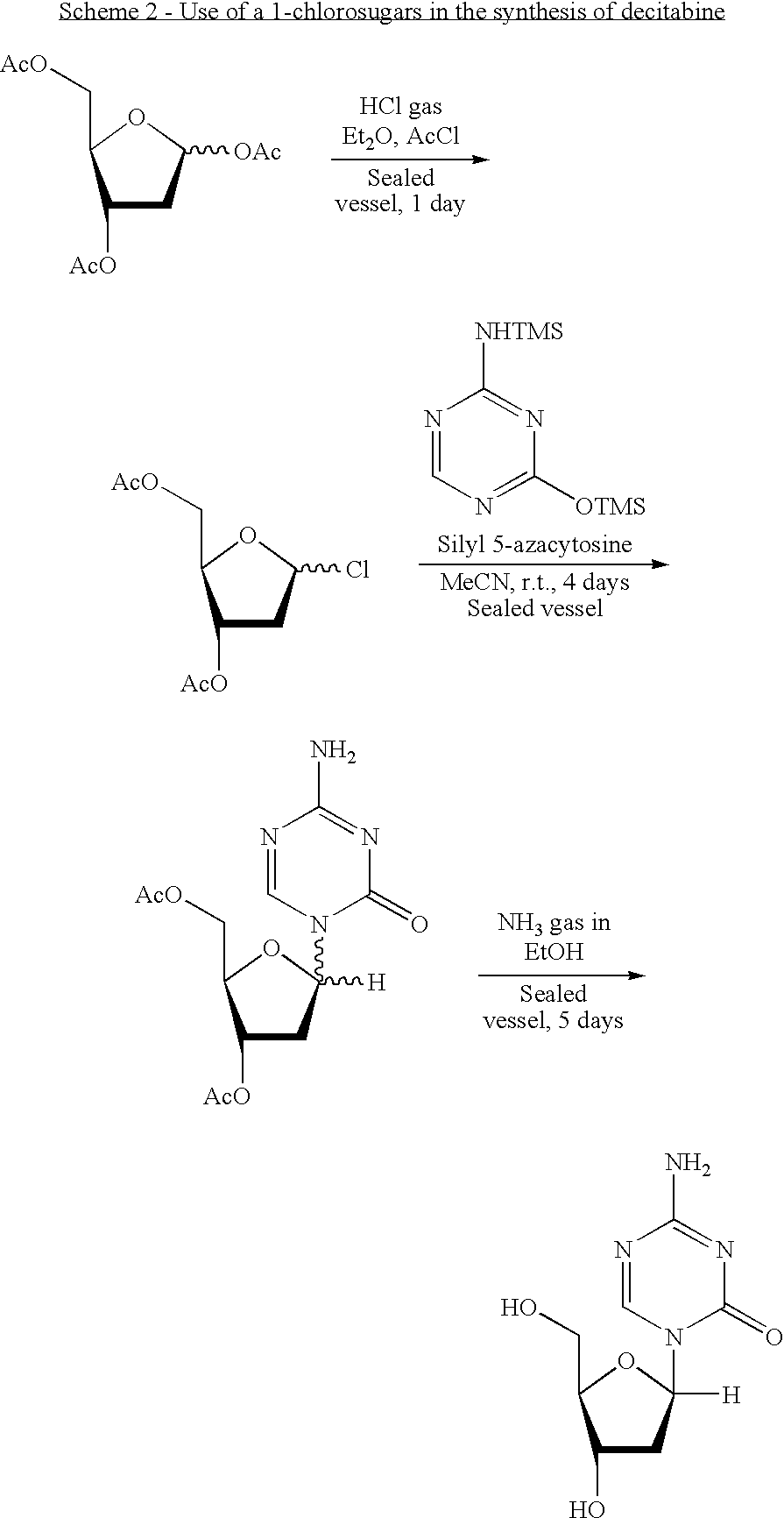Synthesis of Decitabine
a technology of decitabine and azacytosine, which is applied in the field of synthesis of decitabine, can solve the problems of poor or complete lack of anomeric selectivity of the key glycosyl donor and the nucleoside itself, and the commercial manufacture of 5-azacytosine based-nucleosides is difficult, and achieves the effect of increasing yield
- Summary
- Abstract
- Description
- Claims
- Application Information
AI Technical Summary
Benefits of technology
Problems solved by technology
Method used
Image
Examples
example 1
Coupling of silyl 5-azacytosine (IIIa) with Protected 2-deoxy-D-ribofuranose (IIa) to Give Protected Decitabine (Ib+IVa)
[0075]1-O-Acetyl-3,5-di-O-(4-chloro-benzoyl)-2-deoxy-D-ribofuranose (3.603 Kg, 7.68 mol), 2-[(trimethylsilyl)amino]-4-[(trimethylsilyl)oxy]-s-triazine (1.970 Kg, 7.68 mol) and dichloromethane (71.6 Kg) were charged to a suitable reactor. The mixture was cooled to 0° C. TMSOTf (1.791 Kg, 8.06 mol) was added to the solution at 0° C. and stirred for 5 hours. 2M methyl amine in methanol solution (about 3.95 Kg) was then added to the mixture at 0° C. and stirred for 45 mins. The mixture was diluted with dichloromethane (71.6 Kg) and washed with saturated sodium bicarbonate solution (39.8 Kg) at 25° C. The organic layer was dried using molecule sieves (36 Kg). The molecule sieves were filtered and rinsed with dichloromethane (60.1 Kg). The organic layer was evaporated to dryness at 35° C. The solid was milled and vacuum dried at 45° C. to obtain 2.99 Kg (5.92 mol) of 4-a...
example 2
Deprotection of Protected Decitabine (Ib+IVa) to Give Crude Decitabine
[0076]A mixture of 4-amino-1-[3,5-di-O-(4-chloro-benzoyl)-2-deoxy-β-D-ribofuranosyl]-1H-[1,3,5]triazin-2-one in about 50% HPLC purity and 4-amino-1-[3,5-di-O-(4-chloro-benzoyl)-2-deoxy-α-D-ribofuranosyl]-1H-[1,3,5]triazin-2-one (6.15 Kg, 12.17 mol) and methanol (21.4 Kg) were charged into a suitable reactor at about 25° C. 30% Sodium methoxide in methanol solution (0.61 Kg) was added to the mixture solution and then stirred for 5 hours. The solids were filtered, washed with methanol (3.3 Kg) and dried at 50° C. for 14 hours to obtain 0.927 Kg (4.11 mol) crude decitabine in 97.1% HPLC purity (about 67% yield based on 4-amino-1-[3,5-di-O-(4-chloro-benzoyl)-2-deoxy-β-D-ribofuranosyl]-1H-[1,3,5]triazin-2-one (compound Ib)).
example 3
Purification of Crude Decitabine
[0077]Crude decitabine (1.200 Kg, 5.25 mol) and methanol (86 Kg) were charged to a suitable reactor. The mixture was heated to reflux to completely dissolve the crude decitabine. Activated carbon (24 g) was added to the mixture solution at 64° C. and stirred for 1 hour. The mixture was filtered at 64° C. followed by rinsing with methanol (24 Kg). The filtrate was then distilled at 63° C. to suitable volume (90 L). The solution was cooled down to the cloudy point (56° C.) and held for 1 hour at that temperature. The slurry was then cooled to 5° C. and stirred for 4 hours. The solids were filtered, washed with methanol (2.8 Kg) and dried at 50° C. to furnish 0.75 Kg (3.28 mol) decitabine in 99.7% HPLC purity (65% yield based on crude decitabine).
PUM
| Property | Measurement | Unit |
|---|---|---|
| Temperature | aaaaa | aaaaa |
| Temperature | aaaaa | aaaaa |
| Temperature | aaaaa | aaaaa |
Abstract
Description
Claims
Application Information
 Login to View More
Login to View More - R&D
- Intellectual Property
- Life Sciences
- Materials
- Tech Scout
- Unparalleled Data Quality
- Higher Quality Content
- 60% Fewer Hallucinations
Browse by: Latest US Patents, China's latest patents, Technical Efficacy Thesaurus, Application Domain, Technology Topic, Popular Technical Reports.
© 2025 PatSnap. All rights reserved.Legal|Privacy policy|Modern Slavery Act Transparency Statement|Sitemap|About US| Contact US: help@patsnap.com



